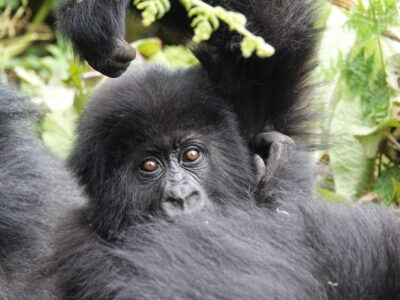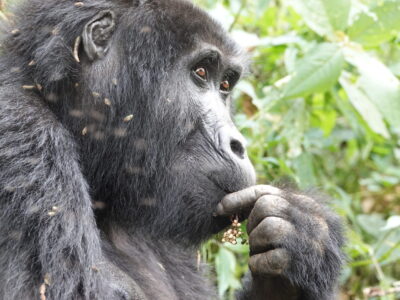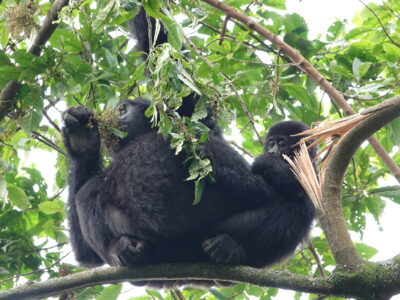Africa Mountain Gorillas: Location, Facts, Size And Behavior
Mountain gorillas are a subspecies of the eastern gorilla, scientifically classified as Gorilla beringei beringei. They inhabit the mountainous regions of Central and East Africa, specifically within four national parks: Bwindi Impenetrable National Park in Uganda, Mgahinga Gorilla National Park in Uganda, Volcanoes National Park in Rwanda, and Virunga National Park in the Democratic Republic of the Congo (DRC).
Mountain Gorillas Location
Mountain gorillas are primarily found in the Albertine Rift montane cloud forests, which range in elevation from 2,200 to 4,300 meters (7,200 to 14,100 feet). Most of these gorillas reside on the slopes of three dormant volcanoes: Karisimbi, Mikeno, and Visoke. The dense vegetation at lower elevations provides a suitable habitat, becoming sparser at higher altitudes.
Virunga Mountain Range: This area spans the borders of Rwanda, Uganda, and the Democratic Republic of Congo (DRC).
- Volcanoes National Park (Rwanda)
- Mgahinga Gorilla National Park (Uganda)
- Virunga National Park (DRC)
Bwindi Impenetrable Forest: Located in Uganda, this UNESCO World Heritage site is home to about half of the world’s remaining mountain gorilla population.
Key Facts
- Scientific Name: Gorilla beringei beringei
- Population: About 1,063 individuals, based on recent conservation efforts.
- Conservation Status: Endangered, but the population has seen growth thanks to conservation efforts.
- Threats: Habitat loss, poaching, disease, and human conflict.
Size
- Males: Typically weigh between 136-195 kg (300-430 lbs) and stand 1.4-1.8 meters (4.6-5.9 feet) tall.
- Females: Smaller, weighing around 68-113 kg (150-250 lbs) and standing about 1.25-1.5 meters (4-5 feet) tall.
Behavior
- Social Structure: Mountain gorillas live in family groups known as troops, usually led by a dominant male called a silverback. Troops can range from 5 to over 30 individuals.
- Diet: Primarily herbivorous, mountain gorillas eat leaves, shoots, fruit, and bark. They occasionally consume ants and insects.
- Movement: They are mostly terrestrial but can climb trees in search of food. Mountain gorillas move by knuckle-walking.
- Communication: Gorillas use various vocalizations to communicate, from roars to grunts. Body language, chest-beating, and facial expressions are also key forms of communication.
- Reproduction: Females give birth to a single infant after a gestation period of around 8.5 months. Infants stay close to their mothers for several years.
Interesting Facts
- Lifespan: Mountain gorillas live for about 35-40 years in the wild.
- Silverbacks: The dominant males are called silverbacks due to the silver streak of hair on their back that develops with maturity, typically after 12 years.
- Tourism: Responsible tourism, like gorilla trekking in Rwanda, Uganda, and DRC, has become a major conservation tool, providing funding for protection efforts.
Mountain gorillas are a symbol of conservation success and an extraordinary example of wildlife in Africa’s mountainous regions.
Learn More About Gorillas
-
- Why is gorilla trekking cheap in Uganda?
- Closest Airport to See Gorillas in Africa?
- Bwindi Vs Volcanoes National Park
- Gorilla Trekking Rwanda Vs Uganda Vs Congo
- Gorilla Trekking Rwanda Vs Uganda
- Age for Gorilla Trekking in Rwanda & Uganda
- Seeing Gorillas in Uganda, Congo & Rwanda
- Gorilla trekking for the elderly and seniors
- Is It Safe to Trek Gorillas in Rwanda?
- Maximum hours to spend with Gorillas
- Gorilla Trekking with Children & Family
- How Many Days Are Needed for Gorilla Trekking?
- Gorilla Trekking Mistakes to Avoid
- Best time to visit Rwanda for Gorillas
- Why Choose Gorilla Trekking in Uganda from Kigali
- Gorilla Trekking on A Budget Cheapest Way to See Gorillas
- Gorilla Trekking in The Rainy Season.
Book Affordable Luxury Gorilla Trekking Tours or Affordable Luxury Gorilla Habituation Experience with JimJam Safaris $ Tours Africa. Africa offers the best primate expeditions for travelers seeking adventure with the gentle giants. Gorilla Trekking in Africa is one of the breathtaking once-in-a-lifetime adventures.
Gorillas Gallery To inspire you
We cater to all ages, budgets, interests, and fitness levels. Our team can assist with queries about Tours, Accommodation, Bookings, and Destinations. We will respond to your Inquiry as soon as possible.



Lear More About Gorillas
- Why is gorilla trekking cheap in Uganda?
- Mistakes to avoid while booking gorilla permits
- Closest Airport to See Gorillas in Africa?
- Bwindi Vs Volcanoes National Park
- Gorilla Trekking Rwanda Vs Uganda Vs Congo
- Gorilla Trekking Rwanda Vs Uganda
- Age for Gorilla Trekking in Rwanda & Uganda
- Seeing Gorillas in Uganda, Congo & Rwanda
- Gorilla trekking for the elderly and seniors
- Is Gorilla Trekking worth the money?
- Is It Safe to Trek Gorillas in Rwanda?
- Rwanda Gorilla Trekking Tours Expert Guide
- Maximum hours to spend with Gorillas
- Gorilla Trekking with Children & Family
- How Many Days Are Needed for Gorilla Trekking?
- Gorilla Trekking Mistakes to Avoid
- Best time to visit Rwanda for Gorillas
- How Hard Is Gorilla Trekking in Uganda?
- Why Choose Gorilla Trekking in Uganda from Kigali
- Gorilla Trekking on A Budget Cheapest Way to See Gorillas
- How Difficult Is Gorilla Trekking in Rwanda?
- Gorilla Trekking in The Rainy Season.
- Days needed for a Uganda Safari
- Are Gorillas Harmful to Human beings?
- Gorilla Trekking Permits in Uganda & Rwanda
Travel Advice From JimJam Safaris
We cater to all ages, budgets, interests, and fitness levels. Our team can assist with queries about Gorillas, tours, Accommodations, bookings, and Affordable Luxury destinations. We will respond to your Inquiry as soon as possible. Our team of friendly and service-minded Safari Consultants is available to assist you in making a private, personalized, tailor-made Safari Itinerary and to answer all questions you might have. Are you dreaming of the Wildebeest Migration? Gorilla Trekking in Africa? Honeymoon In Africa or Africa’s Big 5 Experiences? Start Planning for Your Affordable Luxury African Safaris with JimJam Safaris & Tours Africa.